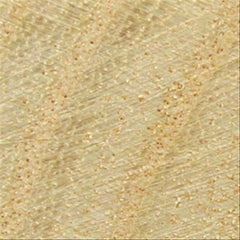

Flat Sawn

Quarter Sawn

End Grain
General Information:
The paulownia tree is originally native to Asia, but is commonly planted in the US as an ornamental tree, or in some cases, for the production of lumber. The tree grows extremely rapidly, and will regenerate from stumps when the trees have been cut down. The wood is extremely lightweight, flexible and durable, and has been used in the production of surfboards, musical instruments, storage boxes and cabinetry work.
Common Name(s):
Royal paulownia, paulownia, kiri, empress tree, princess tree, phoenix tree
Density:
18 lb/ft3 - Low density
Hardness:
260 lbft - Moderately soft
Specific Gravity:
0.25
Turning Properties:
As this wood is quite soft, there is some tendency to tear out when cutting across end grain portions, which will require sanding.
Drying Properties:
Dries quickly compared to many other woods. Warps very little, and has only a slight tendency to check or crack during drying.
Sanding Properties:
Sands very well. For removing tool marks, 120 grit sandpaper is recommended. Will sand to a medium luster, usually requiring grits no higher than 600 to achieve satisfactory results. Remember to check the surface of the wood carefully for scratches and defects when switching to a higher grit sandpaper. Any soft wood such as paulownia will yield a smoother surface in the end if care is taken to remove all scratches left from prior stages of sanding. It is very important to wipe any sanding dust from the wood's surface before changing grits of sandpaper.
Finishing Properties:
Readily accepts most finishes and stains.
Toxicity
No known toxicities are associated with this wood.
Lathe Safety Series, Part 2 - Eye Safety
Last month, we discussed the importance or respiratory safety when working at the lathe. This month, we will discuss proper safety for your vision during woodturning.
Always keep in mind the old saying that "safety is no accident!" Simply knowing, while not following safety procedures is of no benefit. All too often, wood turners can develop serious breathing disorders, injured eyes, broken bones, serious cuts, bruises, and a variety of other ailments. Safety should be taken seriously. This is important especially to beginners, as it is much easier to develop good habits in the beginning than it is to fix bad habits in the future. This said, let's begin taking a look at what you need to know about eye safety!
Proper Safety Gear -
- Safety glasses
Safety glasses are one of the most commonly used types of eye protection. Should you choose to use safety glasses, remember three things: choose glasses which fit properly, have side shields to protect against debris entering through the side of the glasses, and are made from quality impact resistant materials such as polycarbonate to protect against large, heavy items such as flying tools or chunks of broken wood. - Face shields
Face shields provide excellent protection to both your eyes, as well as the rest of your face at the same time. Remember the same three important things should you decide to purchase a face shield, though: find one which provides adequate protection from the side, fits properly, and is made of impact resistant material. - Safety goggles
Safety goggles provide your eyes the most protection, as they allow little, if any debris to come into contact with your eyes. As with safety glasses, though, one must be sure to choose goggles which fit properly, and are made of quality, impact resistant materials.
Proper Visual Positioning -
Remember, most debris that comes off of the lathe will be thrown off perpendicular to the piece of wood on the lathe. Keeping your head and eyes pointed straight towards the piece you are working on at all times when the lathe is running will greatly improve the ability of your safety gear to do its job. I learned this the hard way one afternoon as I reached for a tool near my lathe's head stock. Although I was wearing a full face shield, a bit of undried CA glue flew out of some inlay I had just placed, and came through the rear of the safety shield and into my eye. Trust me, having CA glue in your eye is no fun, and takes many days to finally come out on its own. Don't turn your head, even for a moment!
Be Aware of Wood Toxicity -
Keep in mind that some wood dust can be irritating to the eyes, and in severe cases, can cause temporary blindness. Before working with new woods (especially exotic woods), be sure to educate yourself on any potential toxicity. Most wood dust that turners will ever encounter will at most only produce a slight dryness or minor irritation in the eyes. Be aware of the risks. If you feel any discomfort, discontinue working with the wood you are using, and seek medical attention if symptoms progress or continue to worsen.
In Case of Accidents -
Even when you are prepared, accidents can still occur. If something does occur to injure your eye, be sure to quickly step away from the lathe. It is better to leave the lathe running, than to risk causing further damage to yourself by attempting to shut off the lathe and potentially causing another accident. Care for your eye first, then return to care for the lathe and your work later. We prefer to keep eye wash solution and disposable eye wash cups on site to aid in removing bits of stray sawdust or small wood chips should they get into our eyes. Always seek immediate medical attention for more serious injuries.
All archived monthly newsletters do not include the following:
- Business updates
- Recently added woods and schedule of upcoming woods
- Photo of the month contest results
- Discounts and upcoming sales information
